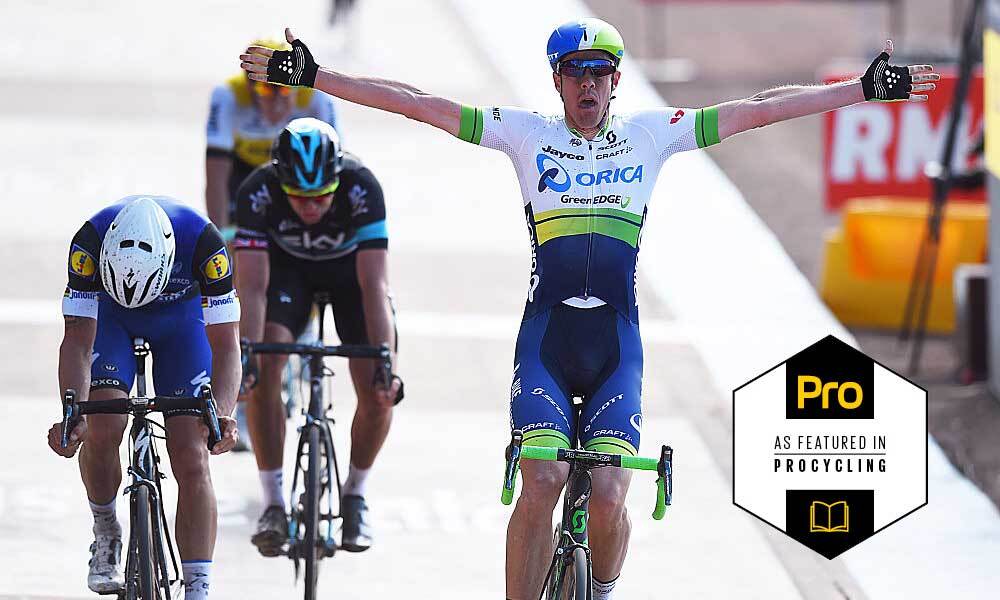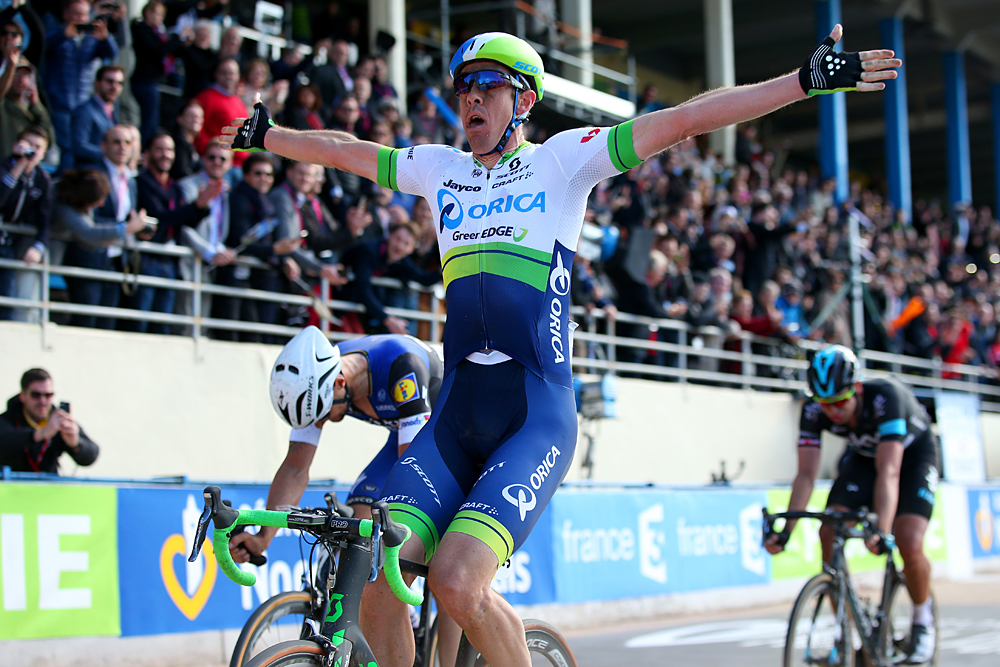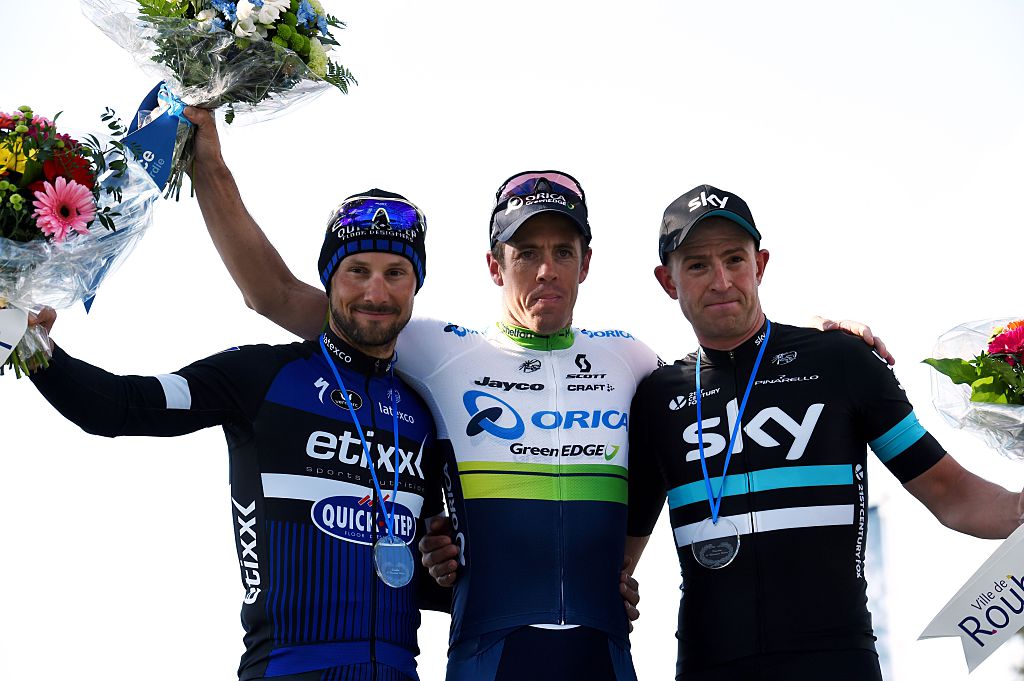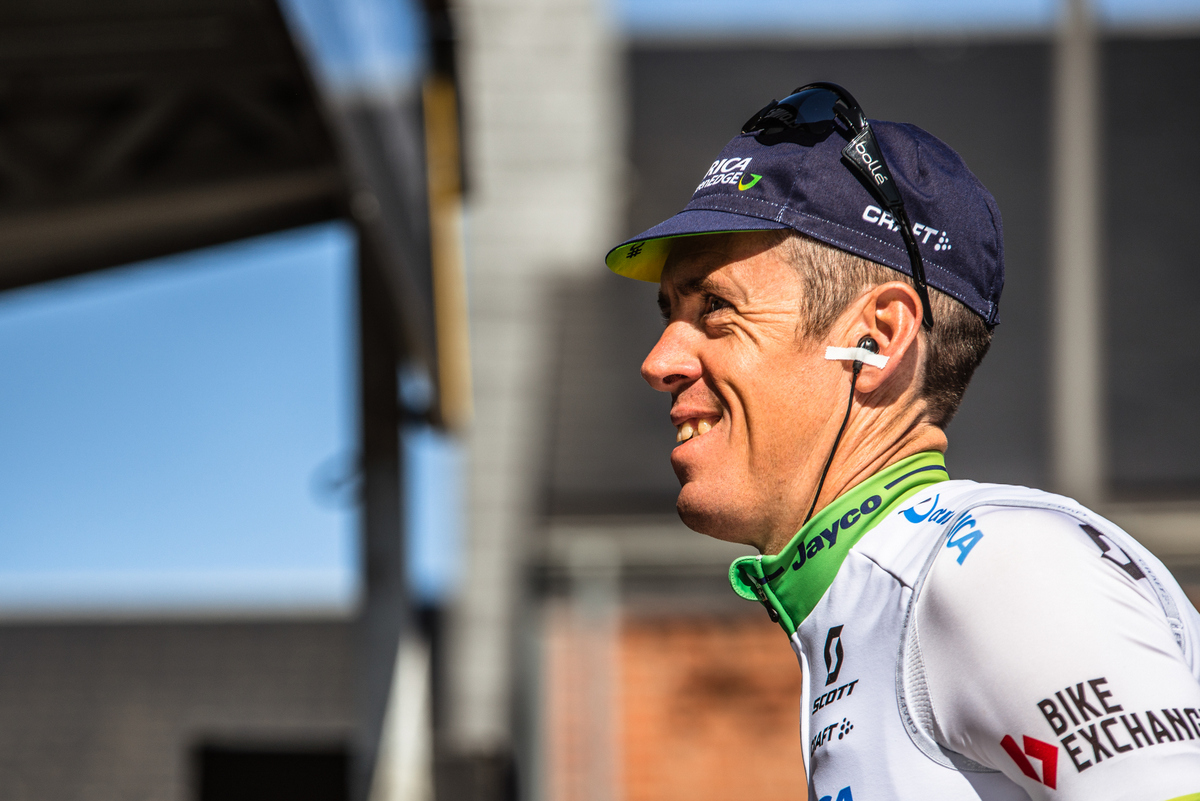Shakedown on the pavé: Mat Hayman's epic Paris-Roubaix win
While a fifth Paris-Roubaix win for Tom Boonen was the anticipated fairytale, victor Mat Hayman gave the race an even better ending, one 16 years in the making

Procycling magazine: the best writing and photography from inside the world's toughest sport. Pick up your copy now in all good newsagents and supermarkets, or get a Procycling subscription.
This article featured in Procycling magazine issue 224 2016
The spring of 2011 produced a series of Classics in which the natural order was in disarray, when the kings were momentarily deposed. Matt Goss was the best sprinter to make the starry eight-man group to contest Milan-San Remo. Nick Nuyens bluffed his way to victory in a pulsating edition of Flanders against, on paper, a much stronger group of rivals. And Johan Vansummeren became the last in a decently long list of usurpers to have their moment in the surprisingly strong northern French sunshine at Roubaix.
In that final race Mat Hayman could smell opportunity. He was riding his 10th Roubaix and he knew that sometimes the coup happened: Knaven, Backstedt and O’Grady had all been unheralded winners during his career. And by that point he had made the first chase group after a typically brutal bloodletting in the Forest of Arenberg. In the closing stages, the remaining favourites, Alessandro Ballan and Thor Hushovd, took their cue from defending champion Fabian Cancellara. The trio made the race weather and Hayman, riding with Juan Antonio Flecha at Sky, steeled himself and tried to make his escape. He launched a few attacks but they didn’t stick. Then Maarten Tjallingii went and Hayman tried to bridge across on the Camphin-en-Pévèle cobbles. He didn’t make it. He trailed home in 10th, with 11 others, 47 seconds back. “Damn,” thought Hayman, “that was my one chance and I stuffed it up.”
It wasn’t, of course. Five years later, Hayman won an edition that lingers in the memory as the best single day of action over the entire season. Where 2011 was predicated on negative tactics, some wheel-sucking and an unlikely escape and evasion, Roubaix 2016 hit a furious rolling boil more than 100 kilometres out and never let up. It was vintage. It was the perfect race.
“A lot of things can happen in Roubaix,” Hayman said, giving a nugget or two of advice to Orica-GreenEdge’s debutant, Luka Mezgec, in Compiègne before the start of the 2016 edition. That Hayman was even on the bus and strapping on a heart rate monitor was near miraculous. “Always keep riding,” he told Mezgec. “You can come back a lot in this race.”
Hayman wins Paris-Roubaix
Paris-Roubaix race highlights - Video
Hayman in disbelief after winning Paris-Roubaix
Meet the aero bike that won Paris-Roubaix: Mathew Hayman's Scott Foil - Gallery
Seven key sectors: Mat Hayman's guide to the Paris-Roubaix cobbles
Hayman: I told my wife to shoot me if I do another year
Hayman to remain with Mitchelton-Scott in non-riding role
It was wisdom that Marc Wauters, now a Lotto-Soudal DS, had first shared with him in his debut season at Rabobank back in 2000. Now Hayman was preparing for
his 15th edition at the age of 37, and he’d reinterpreted the words and applied them to his spring in general.
Get The Leadout Newsletter
The latest race content, interviews, features, reviews and expert buying guides, direct to your inbox!
Six weeks and one day previously, disaster had struck in Omloop Het Nieuwsblad – a race that he’d asked the team management to add to his programme – when he had been involved in a mass pile-up on the Haaghoek cobbles. As he sat on the soggy verge with a high concrete wall looming behind him, the pain in his right arm, a broken radius, signalled the premature end of his 15th Classics campaign in what may turn out to have been his second-last season.
In a way, the news was a blessing. Now he’d be able to go home and spend time with his wife, Kym, and five-year-old son, Harper. He’d done Tour Down Under, two weeks at altitude in South Africa and had been dashing all over the place. After the Omloop weekend it would have been straight to Tirreno-Adriatico and then into the Classics. He was happy he’d get to spend time with his family but he’d much rather it had been after the end of the campaign, when he’d done his job. Mostly the injury was utterly frustrating.
Yet the diagnosis of an uncomplicated fracture, the prognosis of a four-week recovery and an unwillingness to let the underlying good form go to waste meant Hayman started a rigorous regime of ergo training sessions in his garage at home. Surrounded by kids’ bikes, a patio heater and stowed-away outdoor furniture he propped his wrist-to-shoulder plaster-casted arm on a step-ladder and started pedalling. The sweat would run down the plaster and collect at the elbow to form a plaster paste that he dried out with a hair dryer. By the end of the 10 days it was on, the cast had started to stink. He was mildly embarrassed when he went to have it cut off, then disappointed that the healing wasn’t yet complete.
Hayman persevered. He did high intensity training sessions in the morning and low intensity ones in the evening. He fed the power data back to his coach, Kevin Poulton, in Australia. Between the opening Classics weekend and Roubaix, Hayman sweated buckets and rode some 1,000km on his Zwift trainer. A few times he had picked up the phone, called his coach or the team directors and said, “Shouldn’t I forget this? Should I start planning an altitude camp and go to the Giro instead?” Support came from Poulton, who convinced him to keep at it. His sports directors weren’t negative but they were more sceptical.
Hayman hoped to be ready for the Three Days of De Panne but it came around just too early. Flanders looked possible but that idea was set aside because it was probably too hard, too soon. Instead, Hayman flew south, to Spain and the GP Miguel Indurain and Vuelta a la Rioja. While all eyes were on Belgium and the Saganmania that erupted as the rainbow jersey took a solo win, Hayman got around both one-day races unscathed. In fact, better than that, his team-mate Michael Matthews took victory in Rioja. Hayman took careful note of the feeling in his arm. It was a dull ache rather than a sharp stabbing pain when he hit something, so it was good news.
After a couple of days there was more positive feedback from Poulton, who told him that his ‘short power numbers’ from the Spanish races were among his best ever. “Don’t be scared that you’re not going well, because you’re going okay,” Poulton wrote to him in his email. Hayman joined the team for the usual Roubaix recon on the Wednesday and pulled up a bit sore but felt there was nothing there to worry about. It set the horizons for his race

Orica-GreenEdge’s team directors, Matt Wilson and Laurenzo Lapage, had a few options for their Sunday in Hell. Jens Keukeleire had made the final sprint
the year before and finished sixth; Luke Durbridge had been showing strong form. The team would monitor and get into the early breaks and then, in time-honoured Roubaix fashion, see what happened. There was no doubt that the return of Hayman’s experience and horsepower was appreciated – with 14 starts he had more experience than anybody else in the field – but he was under no illusions that he would be granted protection. He wasn’t put out. It wasn’t personal and nor would he have backed a rider who hadn’t raced for five weeks, he thought to himself. Nevertheless, he persuaded Lapage and Wilson to give him a free role. “You know I’m the kind of guy that will always help a team-mate,” he told them. “If I end up in that situation and I know I’m no good, I’ll fall into that role of team-mate, but until that point, can I just see how it goes?” They agreed.
As in 2011, a tailwind blew the peloton north out of Compiègne. Attacks flew from the dropped flag but nothing stuck. After 70km raced, the peloton remained whole. Hayman noted the fatigue setting in among the riders tasked to chase the breaks and decided he’d cover the next one. The 16-man move he hit, along with his team-mate Magnus Cort, was the one that stayed. Usually, Hayman thought, if it’s a late escape that gets away just before the first pavé at Troisvilles, it never builds up a big margin. The race slows down but the break never stands much of a chance. Nevertheless, by sector 20, still with more than 110km to go, the gap was around 3:45 when Etixx-Quick Step suddenly sent Guillaume Van Keirsbulck to the front of the peloton to assist his team-mate, Tony Martin. A moment earlier, a crash had pinched off the pre-race favourites, Peter Sagan and Fabian Cancellera, and Etixx were all over the opportunity. With three powerful groups within two and a half minutes there was no let-up in the action. The brute power and tactical smarts of Tom Boonen and the Etixx team, the courageousness of LottoNL-Jumbo to keep Sep Vanmarcke in the frame, the purpose, incisiveness and then haplessness of Sky, and the moves that put Cancellara and Sagan on the back foot – the race had it all.
For months afterwards – and probably for a few years yet – when Hayman met strangers who watched the race they told him how they couldn’t tear themselves away to get the beers in or find a minute to go to the toilet. Even his family – Kym and Harper, his mum and his brother – were waylaid. They’d been part of a coach party that had stopped off several times to watch the race. Now, parked up near the velodrome, Kym stayed on the bus while Harper slept. No matter: Kym was glued to Sporza’s race feed.

Hayman’s relationship with Paris-Roubaix is complex. It probably started with a bit of physiological determinism: ‘Here’s a big fella, he’ll like the pavé’ sort of thinking. Surrounded by Dutch and Belgians for most of his career and living in Belgium, Hayman bought into that. Then he rode the Queen of the Classics a few times, finished within a couple of minutes of the winner and thought, ‘If things go right, who knows?’ He got to know Roubaix’s lore, its winners and its legends. He might not do it all that often as a road captain but Hayman knows the theory of winning races – particularly Roubaix.
For the final 50 kilometres, Hayman was in the front group and among the five riders who’d go to the line together and assorted others. There were some hairy points, like the moment he almost came down when two Sky riders slid out, or when he got chopped off the back wheel on the Carrefour de l’Arbre. Still, there was time to assess his rivals. Boonen had to win to get the all-out record of five wins. The Belgian, Hayman knew, had identified Sep Vanmarcke as his most dangerous rival and that feeling was probably mutual. Dimension Data’s Edvald Boasson Hagen, so often a factor in Roubaix finales, looked tired. Ian Stannard was more difficult to read, his rocking style deceptive, but previous experience had taught Hayman that give him an inch, he’ll take a mile.
Hayman himself didn’t feel the pressure. After all, he was just happy to be there. In fact, he felt an unusual wave of calm. At 5km to go, near Hem, there was a little rise in the road and Hayman felt a brief stab of worry. Riders slip away here, he thought, and he was desperate to get on that podium. But no sooner than they were cresting it then he was attacking and Vanmarcke was on his wheel. As the velodrome loomed he didn’t think what gear he was going to sprint in, or where he’d position himself on the track. In fact, apart from the imperative of making the podium, Hayman wasn’t really thinking at all. He’d recognise later that he was in a state of mind that Sky’s sports psychologist Dr Steve Peters had tried to foster in him back in the day, where decisions in that finale remained subliminal. He opened the final sprint early, came past Boonen with some speed from the banking and had just enough sparkle in his legs to stay in front.

A win can do funny things to people unaccustomed to the limelight. For Hayman, it wasn’t guilt exactly, but it triggered a weird, misplaced feeling that he’d defied the will of the race. All those people, he caught himself thinking in the podium protocol, had come here wanting Cancellara or Boonen to win.
His concern was partially absolved by the magnanimity of Boonen and also by the compliments from strangers. For months afterwards, whether in French, Spanish, English or Dutch, they always mentioned how great the race had been, that he was a worthy winner. Before the second Sunday of April 2016, he might have felt a pang of regret about 2011, or 2012 when he was eighth, but he won the better race.
The next few days were a blur of sleepless nights, interviews and celebrations. Watching the sprint on news items he felt more anxious than he’d been in the race. He asked himself, did it really happen? Hayman lined up at Brabantse Pijl the Wednesday after and was nervous of the extra attention that would surely come his way. He was braced for the media motos to circle when he was dropped and people talking. In the end, though, he felt more, not less relaxed. He didn’t have anything to prove to anyone; he was a Roubaix winner.
The victory unpacked a lot of emotion, Hayman told us after he’d given his account of the build-up and the day itself, three months or so afterwards at the Tour’s first rest day. “It’s validated a lot of things for me,” he said. “I was happy. I’ve been in great teams, I’ve had a great time and I love the sport…everything was fantastic but it’s kind of made it all that little bit more worthwhile. All the sacrifices and the training – it’s been for something great.”
Procycling magazine: the best writing and photography from inside the world's toughest sport. Pick up your copy now in all good newsagents and supermarkets, or get a Procycling subscription.
Follow @Procycling_mag
Sam started as a trainee reporter on daily newspapers in the UK before moving to South Africa where he contributed to national cycling magazine Ride for three years. After moving back to the UK he joined Procycling as a staff writer in November 2010.